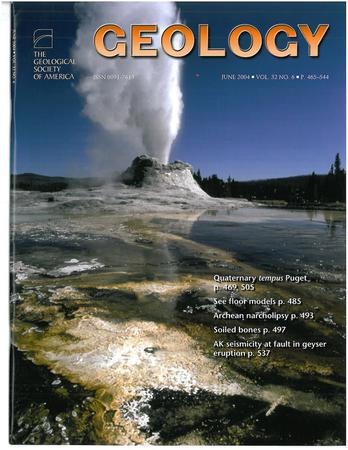Calcite-aragonite seas as a driver of echinoderm evolution? Experimental insight and deep-time decoupling
IF 4.8
1区 地球科学
Q1 GEOLOGY
引用次数: 0
Abstract
Seawater magnesium (Mg) and calcium (Ca) have undergone secular fluctuations throughout the Phanerozoic, controlling whether the dominant calcium carbonate precipitant is calcite or aragonite + high-Mg calcite. Although these oscillations in seawater Mg/Ca ratios have been implicated as an important control on Phanerozoic diversification of calcifying marine organisms, determining the degree to which Mg/Ca ratios affected different clades requires integration of experimental data with historical patterns of biodiversity from the fossil record. We explore short-term and long-term responses of echinoderms to shifting calcite-aragonite seas by combining experimental and deep-time biodiversity investigations. While experimental results support a strong relationship between Mg/Ca ratios and short-term echinoderm regeneration rates, patterns of Phanerozoic echinoderm diversification dynamics show no correspondence with Mg/Ca ratios or calcite-aragonite sea transitions. This decoupling between short- and long-term responses of echinoderms to seawater Mg/Ca ratios suggests echinoderms were relatively unaffected by seawater chemistry throughout their evolutionary history, possibly due to their ability to alter skeletal Mg fractionation and/or adapt to gradual shifts in seawater chemistry. Notably, our results indicate a strict uniformitarian extrapolation of experimental results over geological time scales may not be appropriate for many calcifying marine invertebrates. Instead, the effect of seawater Mg/Ca ratios should be evaluated for individual clades using both experimental and deep-time biodiversity data in a time series.方解石-文石海洋是棘皮动物进化的驱动力?实验洞察力和深度时间解耦
海水镁(Mg)和钙(Ca)在显生宙经历了长期波动,控制了碳酸钙的主要沉淀物是方解石还是文石+高镁方解石。尽管这些海水中Mg/Ca比值的波动被认为是显生宙钙化海洋生物多样化的重要控制因素,但要确定Mg/Ca比值对不同进化分支的影响程度,需要将实验数据与化石记录的生物多样性历史模式相结合。通过实验和深海生物多样性调查,探讨棘皮动物对方解石-文石海洋变化的短期和长期响应。虽然实验结果支持Mg/Ca比率与短期棘皮再生率之间的密切关系,但显生宙棘皮动物多样化动态模式与Mg/Ca比率或方解石-文石海洋转变没有对应关系。棘皮动物对海水Mg/Ca比值的短期和长期反应之间的解耦合表明,棘皮动物在其进化史中相对不受海水化学的影响,这可能是由于它们能够改变骨骼Mg分异和/或适应海水化学的逐渐变化。值得注意的是,我们的结果表明,在地质时间尺度上严格的均变论外推实验结果可能不适用于许多钙化的海洋无脊椎动物。相反,海水Mg/Ca比值对单个支系的影响应该同时使用时间序列的实验和深时间生物多样性数据来评估。
本文章由计算机程序翻译,如有差异,请以英文原文为准。
求助全文
约1分钟内获得全文
求助全文
来源期刊

Geology
地学-地质学
CiteScore
10.00
自引率
3.40%
发文量
228
审稿时长
6.2 months
期刊介绍:
Published since 1973, Geology features rapid publication of about 23 refereed short (four-page) papers each month. Articles cover all earth-science disciplines and include new investigations and provocative topics. Professional geologists and university-level students in the earth sciences use this widely read journal to keep up with scientific research trends. The online forum section facilitates author-reader dialog. Includes color and occasional large-format illustrations on oversized loose inserts.
 求助内容:
求助内容: 应助结果提醒方式:
应助结果提醒方式:


